六年级英语下册(牛津上海版)(沪教版)
沪教牛津版六年级英语下(Unit5 基础知识梳理)

精锐教育学科教师辅导讲义年级:六年级辅导科目:英语课时数:3课题Unit5基础知识梳理教学目的1.使学生能够基本掌握Unit5中的基础词汇词组并且能够进行一些词汇变形练习;2.帮助学生梳理重点句型和语言点。
教学内容Step1: Greetings & Free talkHow are you today? Is there something interesting or important this week?What have you learned in your school? (询问学校课程进度)Step2: Lead in—学海拾贝The Wind And The SunOne day the wind said to the sun, “Look at that man walking along the road. I can get his cloak off more quickly than you can.”“We will see about that,” said the sun. “I will let you try first.”So the wind tried to make the man take off his cloak. He blew and blew, but the manonly pulled his cloak more closely around himself.“I give up,” said the wind at last. “I cannot get his cloak off.” Then the sun tried. Heshone as hard as he could. The man soon became hot and took off his cloak.风和太阳有一天风跟太阳说: “看看那个沿着路上走的人.我可以比你快让他把披风脱下来.“我们等着看吧,”太阳说, “我让你先试.因此风尝试让那个人把披风脱下来.他用力地吹,可是那个人把披风拉得更紧.“我放弃了,”风最后说, “我无法让他把披风脱下来.”然后由太阳试试看.他尽可能地晒他.不久,那个人很热就把披风脱下来了.这则寓言告诉我们温和、友善永远强过激烈与狂暴。
牛津上海版小学英语六年级(三起)下册《Project 1》 课件
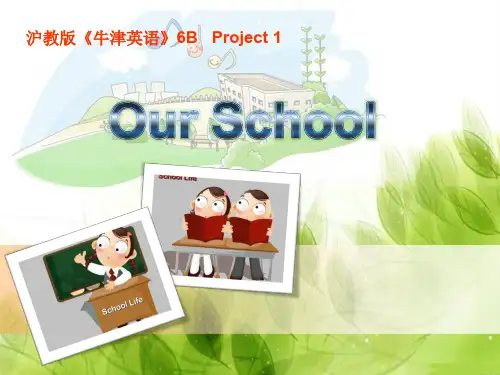
garden
Task 2 : Choose , write and say
In the past
Nowadays
Places
√ building √ library
How? How many?
hall
science room
√ music room
√ computer room
√ classroom √ playground
There will be ________________________ . _______________________________ .
The _______ will ________________ . I will __________________________ . It will be _______________________ . I hope ___________________________ .
Homeall
science room
√ music room
one
√ √
computer room one classroom twenty-four
*In the past , there wasn’t /
√ playground one, small weren’t ____________ .
Places
How?/How many?
√ building √ library
four , short one
hall
science room
√ music room
one
√ computer room √ classroom √ playground
新沪教牛津版六年级下册小学英语全册单元知识点小结
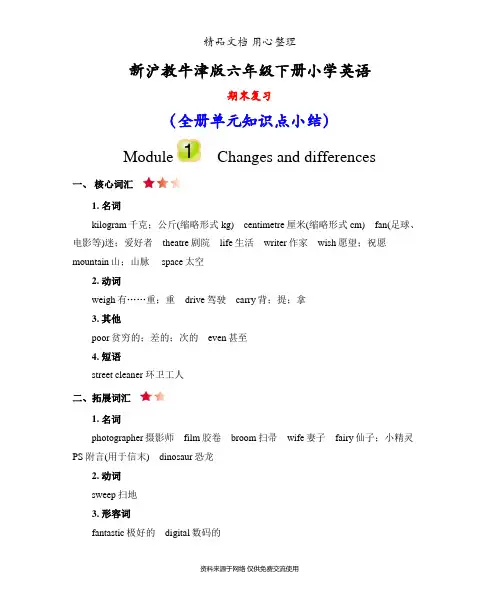
新沪教牛津版六年级下册小学英语期末复习(全册单元知识点小结)Module Changes and differences一、核心词汇1. 名词kilogram千克;公斤(缩略形式kg)centimetre厘米(缩略形式cm)fan(足球、电影等)迷;爱好者theatre剧院life生活writer作家wish愿望;祝愿mountain山;山脉space太空2. 动词weigh有……重;重drive驾驶carry背;提;拿3. 其他poor贫穷的;差的;次的even甚至4. 短语street cleaner 环卫工人二、拓展词汇1. 名词photographer摄影师film胶卷broom扫帚wife妻子fairy仙子;小精灵PS附言(用于信末)dinosaur恐龙2. 动词sweep扫地3. 形容词fantastic极好的digital数码的4. 副词online在线地;在线的5. 代词themselves他们自己;她们自己;它们自己6. 其他taller更高的7. 短语go fishing去钓鱼enjoy oneself玩得愉快;得到乐趣get … in收割street sweeper扫地车by hand用手right away立即;马上in a short time很快head teacher 校长 a piece of一张;一片have a picnic去野餐better and better越来越好三、核心句型1. I’m 150 centimetres tall. 我身高150厘米。
解读:这是介绍身高的句型。
“主语 + be动词 + 数字 + 长度单位(+ tall).”可以用来介绍某人的身高。
举一反三: My cousin is 154 centimetres tall. 我的堂弟身高154厘米。
Jim is 149 centimetres tall. 吉姆身高149厘米。
2. There are a lot of tall buildings in the city. 城市里有很多高大的建筑物。
上海沪教牛津版小学六年级英语下册Unit 1 You and me 习题及答案
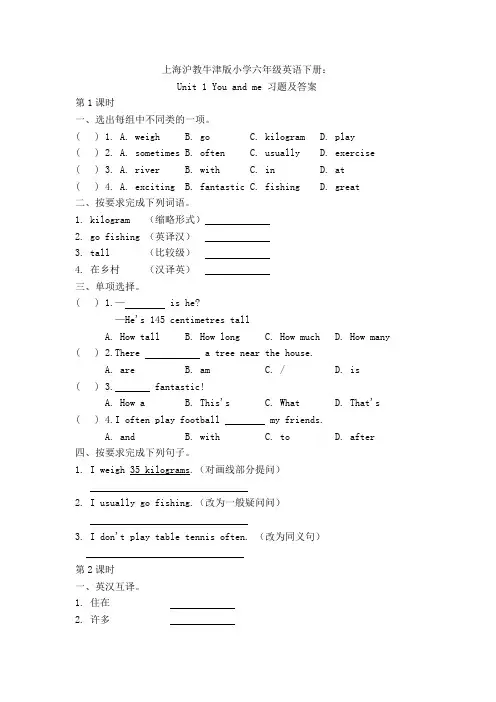
上海沪教牛津版小学六年级英语下册:Unit1You and me习题及答案第1课时一、选出每组中不同类的一项。
()1.A.weigh B.go C.kilogram D.play()2.A.sometimes B.often ually D.exercise ()3.A.river B.with C.in D.at()4.A.exciting B.fantastic C.fishing D.great二、按要求完成下列词语。
1.kilogram(缩略形式)2.go fishing(英译汉)3.tall(比较级)4.在乡村(汉译英)三、单项选择。
()1.—is he?—He's145centimetres tallA.How tallB.How longC.How muchD.How many ()2.There a tree near the house.A.areB.amC./D.is()3.fantastic!A.How aB.This'sC.WhatD.That's ()4.I often play football my friends.A.andB.withC.toD.after四、按要求完成下列句子。
1.I weigh35kilograms.(对画线部分提问)2.I usually go fishing.(改为一般疑问问)3.I don't play table tennis often.(改为同义句)第2课时一、英汉互译。
1.住在2.许多3.at the weekend4.enjoy oneself二、判断图片与所给词语是(T)否(F)一致。
()1.at the theatre()2.in the countryside()3.plant crops 三、选择合适的词语完成句子。
1.My father goes to work car.2.There are many houses gardens.3.George likes ride his bike.4.autumn,farmers get the crops in.四、选出句子中错误的一项并改正。
初中英语 牛津上海版六年级下册Unit7 Travelling in Garden City知识点梳理
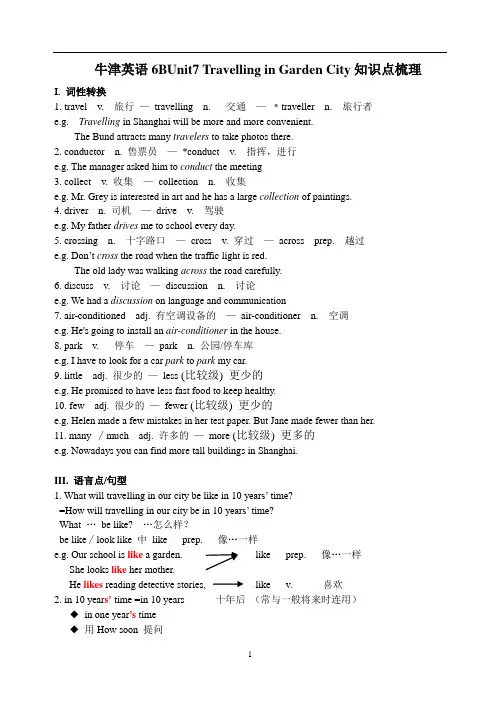
牛津英语6BUnit7 Travelling in Garden City知识点梳理I. 词性转换1. travel v. 旅行—travelling n. 交通—﹡traveller n. 旅行者e.g. Travelling in Shanghai will be more and more convenient.The Bund attracts many travelers to take photos there.2. conductor n. 售票员—*conduct v. 指挥,进行e.g. The manager asked him to conduct the meeting3. collect v. 收集—collection n. 收集e.g. Mr. Grey is interested in art and he has a large collection of paintings.4. driver n. 司机—drive v. 驾驶e.g. My father drives me to school every day.5. crossing n. 十字路口—cross v. 穿过—across prep. 越过e.g. Don’t cross the road when the traffic light is red.The old lady was walking across the road carefully.6. discuss v. 讨论—discussion n. 讨论e.g. We had a discussion on language and communication7. air-conditioned adj. 有空调设备的—air-conditioner n. 空调e.g. He's going to install an air-conditioner in the house.8. park v. 停车—park n. 公园/停车库e.g. I have to look for a car park to park my car.9. little adj. 很少的—less (比较级) 更少的e.g. He promised to have less fast food to keep healthy.10. few adj. 很少的—fewer (比较级) 更少的e.g. Helen made a few mistakes in her test paper. But Jane made fewer than her.11. many ∕much adj. 许多的—more (比较级) 更多的e.g. Nowadays you can find more tall buildings in Shanghai.III. 语言点/句型1. What will travelling in our city be like in 10 years’ time?=How will travelling in our city be in 10 years’ time?What …be like? …怎么样?be like∕look like 中like prep. 像…一样e.g. Our school is like a garden. like prep. 像…一样She looks like her mother.He likes reading detective stories, like v. 喜欢2. in 10 year s’ time =in 10 years 十年后(常与一般将来时连用)◆in one year’s time◆用How soon 提问e.g. The young man will finish riding around the country in two years’ time.How soon will the young man finish riding around the country?3. there be 句型表示事物的存在在什么地方有什么一般现在时:There is∕are一般过去时:There was∕were一般将来时:There will be/ There is going to be4. all of∕most of∕some of∕none of◆all of∕most of∕some of做主语时,后面的名词为复数,谓语动词也为复数e.g. All of the students wear school uniforms.◆none of做主语时,既可用复数谓语动词,也可用单数谓语动词e.g. None of us enjoy(s) getting up early.﹡复习one of的用法﹡可补充与both of∕either of∕neither of 的比较5. in the past∕nowadays∕in 10 years’ time分别与一般过去时,一般现在时,一般将来时连用e.g. In the past, people usually went to work by bike.Nowadays, people go to work by underground.In 10 years’ time, people will drive to work themselves.6. 比较级:little—less, few—fewer, many∕much—more◆fewer traffic jams∕less traffic7. have to do 不得不◆否定形式:don’t have to do = needn’t do∕don’t need to do 不需要e.g. I have to stay at home. I don’t have to stay at home.◆和must 的区别have to do —强调客观的需要,有人称,时态的变化must —强调主观的意愿,没有人称,时态的变化e.g. He broke his leg, so he had to lie in bed for several days.She must study hard, because she wants to be a doctor.8. perhaps= maybe, possibly 也许,可能9. travel by bus=take a bustravel by underground= take the underground10. instead和instead of◆instead单独用于句首句尾,是副词◆instead of 用于名词,代词或介词短语前e.g. I don’t like the red one, give me the black one instead.= Give me the black one instead of the red one.11. transportation n. (美)= transport n.(英)交通工具12. 动词与介词的搭配buy … from 从…买collect … from从…收集put … in把…放入13. a woman driver— five wom e n driver sa man teacher— two m e n teacher s*a girl student — some girl students。
牛津上海版英语六年级下册Unit2Attheaiport单元分析以及优秀教学案例
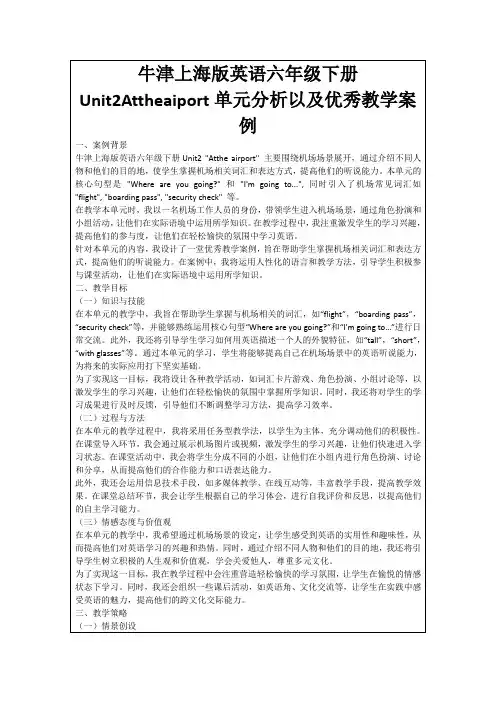
(二)过程与方法
在本单元的教学过程中,我将采用任务型教学法,以学生为主体,充分调动他们的积极性。在课堂导入环节,我会通过展示机场图片或视频,激发学生的学习兴趣,让他们快速进入学习状态。在课堂活动中,我会将学生分成不同的小组,让他们在小组内进行角色扮演、讨论和分享,从而提高他们的合作能力和口语表达能力。
为了更好地创设情景,我会邀请机场工作人员或邀请学生家长分享他们在机场的工作经验,让学生了解到机场工作的实际情况,从而增强他们的学习兴趣和实际应用能力。
(二)问题导向
问题导向教学策略能够激发学生的思考,培养他们解决问题的能力。在本单元的教学中,我将设计一系列问题,引导学生深入思考。例如,在介绍不同人物和他们的目的地时,我会提问:“他们为什么要去那个地方?”“他们在机场会遇到哪些问题?”等问题,让学生在回答问题的过程中,自然而然地掌握所学知识。
为了实现这一目标,我在教学过程中会注重营造轻松愉快的学习氛围,让学生在愉悦的情感状态下学习。同时,我还会组织一些课后活动,如英语角、文化交流等,让学生在实践中感受英语的魅力,提高他们的跨文化交际能力。
三、教学策略
(一)情景创设
在本单元的教学中,情景创设起着至关重要的作用。我将利用多媒体手段,如机场图片、视频等,为学生营造一个真实的机场场景,让他们仿佛身临其境。这样,学生能够更直观地理解教材内容,提高他们的学习兴趣。在情景创设的过程中,我还会注重引导学生运用所学知识进行实际交流,如模拟办理登机手续、询问航班信息等,以提高他们的口语表达能力。
Unit+9+Writing+课件+2023-2024学年牛津上海版英语六年级下册
Action(s) _4__________ Make full use of water.
Look and write
How can we make full use of water?
HWeasishwvaesgheitnagbltehsewviethgethtaebwleastewrituhstehde(w用at过er的u)sefdo(r 用 过cle的an)infogrrciclea. ning rice.
• We can save water by _w_a_s_h_in_g__m_o_p_s_w_i_th_t_h_e_w_a_t_er_u_s_e_d_f_o_r _w_a_s_hi_n_g_v_egetables. • We can save water by _w_a_s_h_in_g__ve_g_e_t_ab_l_e_s_w_it_h_t_h_e_w_a_te_r_u_s_e_d_f_or_c_l_ea_n_ing rice. 2. Change our bad habits of using water. • _W_e_c_a_n_s_a_v_e_w_a_t_e_r b_y__n_ot_u_s_i_ng__th_e_w__as_h_i_n_g_m_a_c_h_in_e_w__he_n__it_is__on_l_y_h_a_lf_-f_u_ll. • _W_e_c_a_n_s_a_v_e_w_a_t_e_r b_y__b_ru_s_h_in_g_o_u_r_t_e_et_h_w_i_th__th_e_t_a_p_o_ff_. ______________ 3. Check the taps regularly(定期地). • _W_e_c_a_n_s_a_v_e_w_a_t_e_r b_y__tu_r_n_in_g_o_f_f _a_d_ri_p_p_in_g_t_a_p._____________________ • _W_e_c_a_n_s_a_v_e_w_a_t_e_r b_y__fi_xi_n_g_a_l_e_ak_y_(__漏_水__的_)__ta_p_. ___________________
沪教版六年级英语下册(上海牛津6B)知识点总结
lazy
懒惰的
take off
脱掉
roof
屋顶
yard
院子
hit
碰撞
see the world
见世面
one by one
一个接一个地
look out of
往外看
even
甚至
themselves
他们自己
sweep
扫地
space
太空
theatre
剧院
broom
扫帚
dinosaur
恐龙
go fishing
去钓鱼
drive
驾驶
a piece of
一张
enjoy oneself
玩得愉快
street sweeper
环卫工人
have a picnic
去野餐
get…in
收割
油
craft
手艺,工艺
long race
长跑
oil painting
油画
crown
王冠
short race
短跑
powerful
强有力的
scissors
剪刀
win
获胜
ink
墨水
tape
胶带
long jump
跳远
brush
画笔,刷子
glue
胶水
high jump
跳高
paints
绘画颜料
saw
锯
swimsuit
kilogram
千克,公斤
writer
作家
online
在线的
centimeter
厘米
photographer
牛津英语上海版六年级下册知识点整理
牛津英语上海版六年级下册知识点整理Module1 City lifeUnit1 Great cities in Asian词组:the capital of... ...的首都 north-east东北 from...to...从...到...in the past在过去 the Great Wall长城 more than=over超过eat dumpling吃饺子 tall buildings高楼大厦huge department stores大型的百货商店 a lot of许多语法点:1.Beijing is north of Shanghai.北京在上海的北部。
(1)两地不相邻:A is north of B.(2)所属关系:A is in the north of B.(3)两地接壤:A is on the north of B.2.How far is it from Shanghai to Beijing?从北京到上海有多远?How far... 多远。
询问距离的远近,路程的长远。
3.How long does it take to travel from Shanghai to Beijing by train?坐火车从上海到北京要多久?(1)How long...多久。
询问时间长短。
How long…多长。
用于询物的问长度。
(2)by+交通工具,表示“乘...交通工具”,用How提问。
4.It takes about ten hours.大约需要十小时It takes (sb.) st. to do sth. 做某事需要花费多长时间。
5.They enjoy eating dumplings.他们喜欢吃饺子enjoy/like/love doing sth. 喜欢做某事6.Two and a half days=Two days and a half两天半Half an hour=one and a half hours=one/an hour and a half一个半小时Unit2 At the airport词组:plane ticket机票 silk scarf丝巾 a lot of/plenty of大量的,许多departure time出发时间 leave for出发去某地 have to不得不be going to将要 arrive at到达boarding card登机牌 name tap姓名语法点:1.Aunt Judy and Uncle Mike have lived in Los Angeles for six years.朱迪婶婶和迈克叔叔在洛杉矶已住了六年。
沪教牛津版六年级下册英语教学设计5篇
T: Look, what did David do on Sunday? (PPT2显示David 在看卡通片)
T: Yes, he watched cartoons. What else did he do ?
(PPT显示David在走向动物园,稍停,等待回答)
T: Now practice in pairs. (PPT3 显示一个男孩和一个女孩的活动,图下有时间和句型)
首先, 这是一个掷筛子的游戏,请根据图片顺序来解释一下游戏规则。
(PPT24--25 显示图片)
(学生尝试解释游戏规则)
2 T: 游戏规则就是象大家所描述的这样:
首先第一个同学根据所掷筛子的数字走棋子,并向第二个同学提问,如果第二个同学答对了就换成第二个同学掷筛子提问;如果答错了,第一个同学进行纠正,并继续掷筛子。
(稍等)
引导学生使用句型: Whose… is it/are they? It’s /They’re mine/his/hers/ours.
造句。复习第七单元名词性物主代词的用法。
(本步骤设计说明:本单元是综合复习,在本部分,教师安排对话、交流等形式复习旧知,为本课练习做铺垫。)
第二步:单元各板块综合练习
3 (出示PPT14--16核对正确答案,讲解易错部分)
(三) C Look, read and complete
1 T:刚才,我们练习的都是口头表达,下面我们来试试书面表达. Look!
(PPT17--19 显示各个单元重点句式中容易出错的地方,需要强调之处均为空白; 在引导学生自主归纳的基础上,出示PPT完整内容)
T: We know we can get some presents on Christmas day. And last year, on
